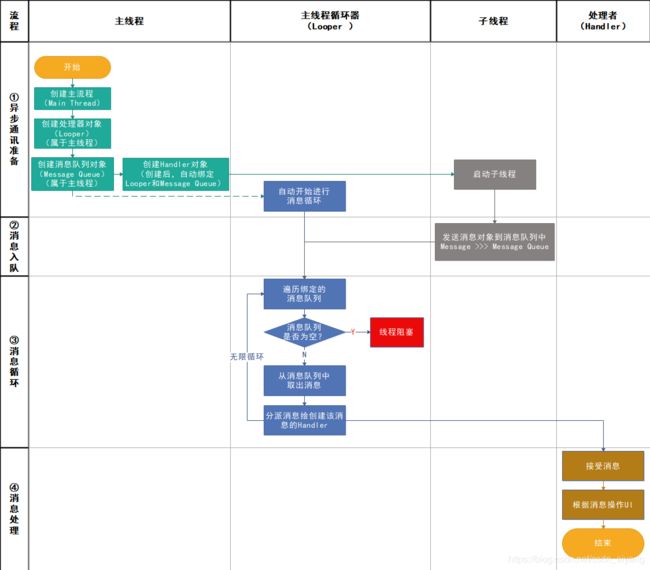Android 性能优化(二)Handler运行机制原理,源码分析
目录
前言
一、Looper轮询器
二、Handler处理者
三、MessageQueue消息队列
四、Message消息载体
五、小结
面试题:
前言
Handler机制是Android中非常重要的技术点,几乎所有的面试都会涉及到这个问题,那么为什么说它这么重要呢?因为Handler机制几乎贯穿了整个应用从启动到结束,包括Throwable抛出异常、View绘制、事件分发、Activity启动、Activity生命周期等都涉及到Handler机制。
我们知道,主线程中不建议耗时操作,子线程中不允许更新UI,所以一般我们在开发中都会Handler机制来保证线程安全。Handle运行依赖于Looper、MessageQueue和Message ,整体流程如下:
在应用启动时会开启一个主线程,默认会创建一个Looper对象关联当前线程,且系统规定一个线程只允许创建一个Looper实例对象。另外,创建Looper对象同时实例化了一个MessageQueue对象,因此一个线程中对应唯一的Looper对象和MessageQueue对象。主线程中完成Looper对象创建后会调用Looper.loop()方法,进行消息循环,不断地获取
MessageQueue中的Message对象,然后调用与Message绑定的Handler对象的dispatchMessage方法实现接口回调,从而更新handle所在的主线程的UI。
流程图如下:
一、Looper轮询器
Looper是Handler机制运行工作的核心,所以我们先搞懂Looper是怎么回事很关键。我们知道应用的启动通过main方法作为入口,这个main方法在主线程中,查看这个类的main方法可以看到有两个方法:
Looper.prepareMainLooper()、Looper.loop()。
public static final void main(String[] args) {
...
//主线程中调用Looper.prepareMainLooper()方法创建Looper
Looper.prepareMainLooper();
if (sMainThreadHandler == null) {
sMainThreadHandler = new Handler();
}
ActivityThread thread = new ActivityThread();
thread.attach(false);
if (false) {
Looper.myLooper().setMessageLogging(new
LogPrinter(Log.DEBUG, "ActivityThread"));
}
//主线程中调用Looper.loop(),开始轮询,取消息
Looper.loop();
...
}
}首先,ActivityThread首先调用的Looper.prepareMainLooper()方法,我们来看一下这个方法源码都做了些什么?
在Looper类中
public static final void prepareMainLooper() {
prepare();
setMainLooper(myLooper());
if (Process.supportsProcesses()) {
myLooper().mQueue.mQuitAllowed = false;
}
}原来,该方法中首先调用本类中的prepare()方法创建Looper对象,并且把该对象setMainLooper()绑定到当前线程中。在这里既然是主线程调用的,那么该Looper对象自然是在主线程当中。继续看里面的prepare()这个方法:
在Looper类中
public static final void prepare() {
if (sThreadLocal.get() != null) {
throw new RuntimeException("Only one Looper may be created per thread");
}
//把Looper绑定到当前线程
sThreadLocal.set(new Looper());
}这个方法只做了一个事情,就是保证当前线程只能存在一个Looper对象,如果已经存在就会抛出异常(Android规定一个线程只允许关联一个Looper)。
继续看new Looper()这个构造方法,我们可以看到:
private Looper() {
mQueue = new MessageQueue();
mRun = true;
mThread = Thread.currentThread();
}Looper这个类的构造方法是private私有的,不允许外界直接new出来Looper对象,而最重要的是:在创建Looper的时候,同时创建了一个消息队列MessageQueue。所以请注意!MessageQueue是依赖Looper一起创建的。
然后,看ActivityThread调用Looper.loop()方法,开始轮询消息:
public static final void loop() {
Looper me = myLooper();
//通过Looper对象,获取MessageQueue
MessageQueue queue = me.mQueue;
...
//死循环获取消息
while (true) {
//调用MessageQueue的next()方法取消息,这个过程也是死循环
Message msg = queue.next();
if (msg != null) {
...
//取到消息之后,交给发送该消息的Handler取处理消息
msg.target.dispatchMessage(msg);
...
//回收消息,在Message中维护的有一个消息池
msg.recycle();
}
}
}从上述源码中简单的注解,我们可以直观明白主线程的Looper和对应的MessageQueue之间最直接的关系了。但是我们带着一个问题如何把Message消息从子线程交给Handler在主线程中处理的?继续分析msg.target.dispatchMessage()源码:
public void dispatchMessage(Message msg) {
if (msg.callback != null) {
handleCallback(msg);
} else {
if (mCallback != null) {
if (mCallback.handleMessage(msg)) {//注意这个方法调用
return;
}
}
handleMessage(msg);
}
}我们可以知道Looper.loop()方法里的死循环是不断地获取MessageQueue中的Message,然后调用与Message绑定的Handler对象的dispatchMessage方法。最后,我们终于明白原来Handler的handleMessage就在这里调用的,其实就是一个接口回调啊。
二、Handler处理者
我们知道Handler的工作主要就是发送和处理消息。其实Handler的构造方法有多种,但都会获取当前线程的Looper对象和MessageQueue对象。这个其实也没什么,看看就好:
//Handler的构造方法1
public Handler() {
...
//获取当前线程的Looper对象
mLooper = Looper.myLooper();
if (mLooper == null) {
throw new RuntimeException(
"Can't create handler inside thread that has not called Looper.prepare()");
}
//获取消息队列对象
mQueue = mLooper.mQueue;
mCallback = null;
}
//Handler的构造方法2
public Handler(Callback callback) {
...
mLooper = Looper.myLooper();
if (mLooper == null) {
throw new RuntimeException(
"Can't create handler inside thread that has not called Looper.prepare()");
}
mQueue = mLooper.mQueue;
mCallback = callback;
}
//Handler的构造方法3
public Handler(Looper looper) {
mLooper = looper;
mQueue = looper.mQueue;
mCallback = null;
}
//Handler的构造方法4
public Handler(Looper looper, Callback callback) {
mLooper = looper;
mQueue = looper.mQueue;
mCallback = callback;
}发送消息可以通过一系列send方法,也可以通过一系列post方法,不过post方法最终还是通过send方法去实现。
用send方法,最终也会调用一个方法如下:
//在Handler中
public boolean sendMessageAtTime(Message msg, long uptimeMillis)
{
boolean sent = false;
MessageQueue queue = mQueue;
if (queue != null) {
//调用msg.target的方法把Message和发送它的Handler绑定,所以Looper能够把正确的Message交给发送它的Handler处理
msg.target = this;
//调用MessageQueue的enqueueMessage方法把消息加入消息队列
sent = queue.enqueueMessage(msg, uptimeMillis);
}
else {
RuntimeException e = new RuntimeException(
this + " sendMessageAtTime() called with no mQueue");
Log.w("Looper", e.getMessage(), e);
}
return sent;
}可以看到,Handler发送消息的过程就是向消息队列中插入一条消息。前面已经讲到,MessageQueue调用next方法去轮询消息,那么当MessageQueue拿到消息之后,把消息传递给Looper,最终交给Handler去处理,即dispatchMessage方法会被调用。此时,Handler开始处理消息。值得一提的是,在消息队列中可能有不同Handler发送的多个消息,通过在发送消息的时候把Message和发送它的Handler绑定,Looper就会把消息正确的交给发送它的Handler来处理。dispatchMessage方法如下:
//Handler中
public void dispatchMessage(Message msg) {
if (msg.callback != null) {
handleCallback(msg);
} else {
if (mCallback != null) {
if (mCallback.handleMessage(msg)) {
return;
}
}
handleMessage(msg);
}
}Handler处理消息的过程:
第一步,查看Message的callback是否为null,不为null就通过handleCallback(msg)方法处理消息。这里的callback实际上就是一个Runnable对象。如果以post方式去发送消息,最终就会调用handleCallback(msg)方法去处理,这个方法内容为:
private final void handleCallback(Message message) {
message.callback.run();
}第二步,检查mCallBack是否为null,如果不为null就调用mCallBack的handleMessage(msg)方法。这个mCallBack是CallBack接口的子类对象,前面已经说过Handler的构造方法中有两个可以用到这个CallBack。如果mCallBack为null,最终就会调用Handler的handleMessage(msg)方法,这个方法通常是在创建Handler时被使用者重写的方法。
需要说明:在主线程当前我们创建Handler时并没有自己创建Looper对象,这是因为主线程已经为我们创建好了;如果要在子线程当前创建Handler,一定要在之前创建Looper对象,即调用Looper.prepare()方法。
三、MessageQueue消息队列
前面的内容已经讲了很多关于MessageQueue的东西,这里就总结下了。MessageQueue主要包含两个操作:插入消息(enqueueMessage方法)和读取消息(next方法)。读取的过程也伴随着删除操作。MessageQueue的的内部实际上是通过一个单链表的数据结构来维护消息列表,这主要也是因为单链表在插入和删除上比较有优势。
final boolean enqueueMessage(Message msg, long when) {
...
Message p = mMessages;
if (p == null || when == 0 || when < p.when) {
// 当前发送的message需要马上被处理调,needWake唤醒状态置true
msg.next = p;
mMessages = msg;
needWake = mBlocked; // new head, might need to wake up
} else {
// 当前发送的message被排队到其他message的后面,needWake唤醒状态置为false
Message prev = null;
while (p != null && p.when <= when) {
prev = p;
p = p.next;
}
msg.next = prev.next;
prev.next = msg;
needWake = false; // still waiting on head, no need to wake up
}
}
// 是否唤醒主线程
if (needWake) {
nativeWake(mPtr);
}
return true;
}enqueueMessage的主要操作其实就是单链表的插入操作,根据时间看当前发送的Message是否需要马上处理。这个enqueueMessage方法是Handler发送消息的时候调用。
下面来看next方法:
final Message next() {
int pendingIdleHandlerCount = -1; // -1 only during first iteration
int nextPollTimeoutMillis = 0;
for (;;) {
if (nextPollTimeoutMillis != 0) {
Binder.flushPendingCommands();
}
nativePollOnce(mPtr, nextPollTimeoutMillis);
synchronized (this) {
// Try to retrieve the next message. Return if found.
final long now = SystemClock.uptimeMillis();
final Message msg = mMessages;
if (msg != null) {
final long when = msg.when;
if (now >= when) {
mBlocked = false;
mMessages = msg.next;
msg.next = null;
if (Config.LOGV) Log.v("MessageQueue", "Returning message: " + msg);
return msg;
} else {
nextPollTimeoutMillis = (int) Math.min(when - now, Integer.MAX_VALUE);
}
} else {
nextPollTimeoutMillis = -1;
}
...
}注意"return msg",是next方法返回一个Message对象。next方法中也是采用阻塞的方式去获取消息队列中的消息,一旦有消息立即返回并且将它从单链表中移除。如果没有消息就一直阻塞。前面已经提到,这个取消息的next方法是在Looper的loop()方法中调用。
四、Message消息载体
Message只有一个无参构造方法,但是Message有多个obtain静态方法来返回Message对象。
采用哪种方式创建Message对象都可以,但是建议采用obtain方法来创建。这是因为Message通过在内部构建一个链表来维护一个被回收的Message对象池。当用户调用obtain方法时会优先从池中获取,如果池中没有则创建新的Message对象。同时在使用完毕之后,进入池中以便于复用。这个在Looper.loop()方法可以看到一点端倪,在使用完毕时候调用了Message的recycle()方法。
下面是obtain方法创建Message对象的流程:
public static Message obtain() {
synchronized (sPoolSync) {
if (sPool != null) {
Message m = sPool;
sPool = m.next;
m.next = null;
sPoolSize--;
return m;
}
}
return new Message();
}
五、小结
- 在应用启动时会开启一个主线程,默认创建一个Looper对象绑定当前线程,且不同线程间的Looper不能共享。
- 一个Thread线程对应一个Looper对象、对应一个MessageQueue对象。
- 主线程中调用Looper的loop()方法,会开启消息循环,不断的从消息队列中拿到消息。
- Looper拿到消息之后调用Handler的dispatchMessage方法来处理消息。
- 一个Thread线程对应多个Handler。
- Handler通过send、post方法,把消息加入消息队列MessageQueue中。
- 子线程中创建Handler需先创建Looper对象,Thread与Handler共享一个Looper与MessageQueue。
面试题:
Looper.loop()为什么不会阻塞主线程?
IdHandler(闲时机制)?
postDelay()的具体实现?
post()与sendMessage()区别?
使用Handler时怎么解决内存泄漏的问题的?
